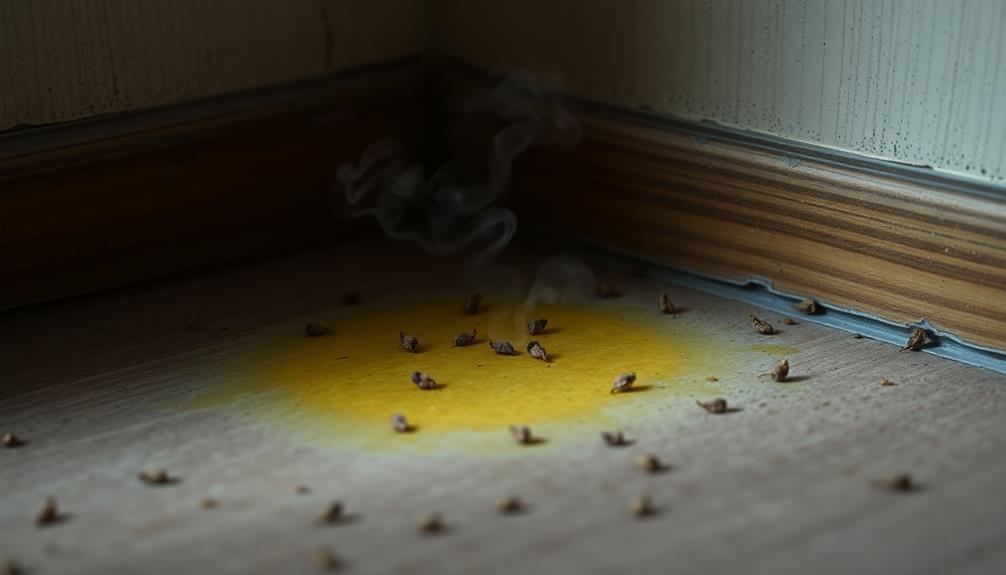When you encounter a dead human body, the smell evolves dramatically. Initially, it might have a stale sweetness, but it quickly turns pungent, resembling rotting meat or garlic. This intense odor arises from tissue breakdown and gas release, with compounds like hydrogen sulfide and putrescine contributing to its foulness. The scent becomes strongest around 72 hours after death. If it's warm and humid, you'll notice it even more strongly. This odor can trigger deep emotions, evoking responses tied to grief and loss. Keep exploring, and you'll discover more about the fascinating aspects of decay and its impact on us.
Key Takeaways
- The smell of a dead human body evolves from a sweet, stale scent to a pungent aroma resembling rotting meat and garlic over time.
- Initial decay odors are sweet and fruity but become increasingly intense and unpleasant around the 72-hour mark of decomposition.
- Key compounds contributing to the smell include hydrogen sulfide, cadaverine, putrescine, and methanethiol, producing earthy and sewage-like aromas.
- Environmental factors like temperature, humidity, and enclosed spaces significantly amplify and accelerate the release of decay odors.
- Cultural and emotional contexts influence individual responses to these smells, often evoking feelings of grief or loss.
Introduction

The distinctive smell of a dead human body can be both haunting and fascinating. When you encounter the dead body smell, you're typically met with a complex blend of chemical compounds that signal the beginning of decomposition. Initially, a fresh corpse might emit a stale, sweet aroma, almost deceptive in its subtlety. As time passes, the scent evolves into something far more pungent, resembling rotting meat and garlic, which can be overwhelming.
Factors like the environment, cause of death, and time elapsed since death heavily influence these smells. For example, hydrogen sulfide contributes a rotten egg odor, while compounds like cadaverine and putrescine create that strong, rotting flesh scent. Others, such as skatole and indole, add earthy and sewage-like notes to the mix. It's interesting to note how cultural interpretations of these odors vary; some see them as a natural part of life, while others might find them unsettling or terrifying. Understanding the nuances of the dead body smell can help you appreciate the intricate processes of life, death, and decay—no matter how uncomfortable they may feel.
Description of the Smell

A dead human body emits a powerful, unmistakable odor that many describe as akin to rotting meat, thanks to the breakdown of tissues and the gases released by bacteria. This smell is strong and pungent, characterized by a foul, putrid aroma that can linger in the air. As decomposition progresses, the scent intensifies significantly, especially around the 72-hour mark when active decay begins.
Compounds like cadaverine and putrescine contribute to this distinctive smell, making it one of the most unpleasant experiences you can encounter. You might find that the odor can evoke strong emotional responses, reminding you of loss and grief if you've experienced the death of a loved one.
Environmental factors, such as temperature and humidity, can play a crucial role in how the smell manifests. Warmer and moister conditions accelerate the decomposition process, leading to an even more pronounced odor. Whether you're close to the body or merely in the vicinity, the smell of a dead body is something that's hard to forget, lingering in your memory long after the moment has passed.
Source and Composition

Decomposition is where the unmistakable smell of a dead human body starts. As the body breaks down, microbial activity kicks in, leading to the release of various chemical compounds that create that distinctive odor. The primary culprits include hydrogen sulfide, which has a rotten egg scent, and cadaverine and putrescine, responsible for the smell akin to rotting flesh.
As decomposition continues, other compounds like skatole and indole contribute earthy and sewage-like aromas, while methanethiol adds a hint of rotting cabbage. This cocktail of odors intensifies particularly in warm and moist environments, as the process of putrefaction accelerates the release of these scents.
You should also note that the variability in the smell can be influenced by the cause of death, environmental conditions, and the individual's unique biochemical composition. Each body might emit a slightly different aroma, making the scent of death a complex and multifaceted experience. Understanding the source and composition of these chemical compounds can give you insight into the stages of decomposition and the factors affecting the odor you encounter.
Typical Scenarios or Environments

Experiencing the unmistakable odor of a dead human body often occurs in specific scenarios and environments, particularly within enclosed spaces. The smell of death typically becomes apparent within 72 hours post-mortem, as decomposition sets in, releasing a strong stench reminiscent of rotting meat and garlic. In homes or vehicles, the confined space can amplify this odor, creating an overpowering atmosphere that may be mistaken for plumbing issues or other unpleasant smells.
Environmental factors play a crucial role, too. High temperatures and humidity can accelerate the decomposition process, intensifying the smell. If the cause of death involves necrotic tissue, such as advanced cancer, the odor can be particularly foul. As decomposition progresses, specific compounds like cadaverine, putrescine, and hydrogen sulfide are released, contributing to the characteristic scent of death.
In these scenarios, the accumulation of gases can create a dangerously toxic environment, making it essential to recognize the smell early. Understanding these typical environments can help you identify the presence of a dead body and take appropriate action.
Emotional or Cultural Associations

Throughout history, cultures have shaped their interpretations of the scent of death, leading to varied emotional responses tied to this powerful olfactory experience. For many, the smell of a dead human body evokes feelings of grief and loss, acting as a poignant reminder of mortality. In some cultures, this scent is romanticized as a natural part of life, while others find it terrifying and eerie, reflecting their beliefs about death and the afterlife.
Floral scents often replace the harshness of decay during mourning rituals, symbolizing remembrance and honoring the deceased. Conversely, incense or spices may fill the air in other ceremonies, creating a comforting atmosphere that celebrates life rather than solely focusing on loss. These cultural associations with the scent of death significantly influence how you cope with grief, shaping your emotional responses.
As scents trigger vivid memories tied to personal experiences and community rituals, the aroma of a dead human body can connect you deeply to collective memories. It's fascinating how something as simple as a smell can evoke such intense emotions and influence the ways cultures handle the inevitable reality of death.
Health or Safety Considerations

The emotional weight of the scent of death can quickly give way to serious health and safety concerns. Decomposition releases odors containing hazardous compounds like hydrogen sulfide and cadaverine, which can cause respiratory irritation, wheezing, and skin reactions upon exposure. If you're nearby, prolonged exposure can trigger a fight or flight response, leading to anxiety and distress.
Additionally, biological hazards from decomposition can introduce harmful microorganisms into the environment, creating contamination risks that need urgent attention. Symptoms of exposure can range from mild irritations, such as watery eyes and throat discomfort, to more severe reactions, underscoring the importance of using personal protective equipment (PPE) during cleanup.
That's why it's crucial to call in professional biohazard teams. These experts ensure safe decontamination and proper disposal of materials affected by decomposition, which helps prevent further health risks to you and your community. Don't underestimate the dangers involved; addressing these issues swiftly and effectively is vital for everyone's safety.
Final Thoughts

Confronting the smell of a dead human body can be a chilling experience that lingers in your memory. The scent, primarily stemming from decomposition, is characterized by strong odors like cadaverine and putrescine, which evoke images of rotting flesh. As the body decomposes, this scent becomes more pronounced, particularly within the first 72 hours post-mortem when it transitions through various stages of decay.
You might find that environmental factors, such as temperature and humidity, can significantly alter the odors emitted by dead bodies. For instance, moisture can accelerate decomposition, intensifying the smell. Conversely, embalmed bodies often present a different scent due to chemicals designed to mask natural decay odors.
Cultural perceptions surrounding these scents vary immensely. While some may associate the natural odors of decay with mourning or loss, others might find them distressing or unsettling. Ultimately, understanding the complexity of these smells gives you a deeper appreciation for the process of death and its impact on our senses. Recognizing these nuances can help you navigate the emotional and psychological responses tied to encountering the scent of dead bodies.
Frequently Asked Questions
What Does a Dead Body Smell Like?
When you encounter a dead body, you're likely to notice a strong, unpleasant odor. It often resembles rotting flesh or decaying meat, which can trigger intense emotional reactions. After a few days, the smell intensifies, releasing scents that might remind you of rotten eggs. Individual circumstances can alter the scent, leading to variations. Your body may react physically, causing irritation in your nose and throat, or even triggering a fight or flight response.
How Long After Death Can You Smell a Body?
You'll typically start to notice a body's smell within 24 to 72 hours after death. Initially, the odor might be subtle, but as decomposition accelerates, it becomes more pronounced. By the third day, you might detect stronger, unpleasant scents. Environmental factors like temperature and humidity can affect how quickly these odors develop, so it's important to consider those conditions. Ultimately, expect the smell to intensify as time passes.
How Far Away Can You Smell a Dead Body?
You can smell a dead body from quite a distance, often up to a mile under the right conditions. Factors like wind, humidity, and temperature play a huge role in how far the odor travels. In open areas, the scent disperses more easily, while enclosed spaces might trap it. Your sensitivity to these smells also matters; some people can detect them from further away than others, depending on their olfactory capabilities.
How Long After Death Does the Body Release Urine?
After death, your body can release urine within a few hours to a day. This happens because muscle tone is lost and bladder control is gone. As decomposition starts, fluids accumulate and eventually get expelled. The exact timing can vary based on factors like the cause of death and environmental conditions. So, you might notice this occurrence quite quickly as the body begins to break down.









